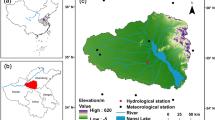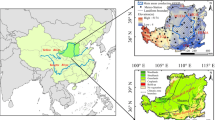Abstract
Net primary productivity (NPP) of the vegetation in an oasis can reflect the productivity capacity of a plant community under natural environmental conditions. Owing to the extreme arid climate conditions and scarce precipitation in the arid oasis regions, groundwater plays a key role in restricting the development of the vegetation. The Qira Oasis is located on the southern margin of the Taklimakan Desert (Tarim Basin, China) that is one of the most vulnerable regions regarding vegetation growth and water scarcity in the world. Based on remote sensing images of the Qira Oasis and daily meteorological data measured by the ground stations during the period 2006–2019, this study analyzed the temporal and spatial patterns of NPP in the oasis as well as its relation with the variation of groundwater depth using a modified Carnegie Ames Stanford Approach (CASA) model. At the spatial scale, NPP of the vegetation decreased from the interior of the Qira Oasis to the margin; at the temporal scale, NPP of the vegetation in the oasis fluctuated significantly (ranging from 29.80 to 50.07 g C/(m2·month)) but generally showed an increasing trend, with the average increase rate of 0.07 g C/(m2·month). The regions with decreasing NPP occupied 64% of the total area of the oasis. During the study period, NPP of both farmland and grassland showed an increasing trend, while that of forest showed a decreasing trend. The depth of groundwater was deep in the south of the oasis and shallow in the north, showing a gradual increasing trend from south to north. Groundwater, as one of the key factors in the surface change and evolution of the arid oasis, determines the succession direction of the vegetation in the Qira Oasis. With the increase of groundwater depth, grassland coverage and vegetation NPP decreased. During the period 2008–2015, with the recovery of groundwater level, NPP values of all types of vegetation with different coverages increased. This study will provide a scientific basis for the rational utilization and sustainable management of groundwater resources in the oasis.
Similar content being viewed by others
References
Bi X, Li B, Zhang L X, et al. 2020. Response of grassland productivity to climate change and anthropogenic activities in arid regions of Central Asia. Peer J, 8(6): e9797, doi: https://doi.org/10.7717/peerj.9797.
Chen Y N, Li W H, Xu H L. 2003. The influence of groundwater on vegetation in the lower reaches of Tarim River, China. Acta Geographica Sinica, 58(4): 542–549. (in Chinese)
Ding J L, Tiyip T, Liu C S. 2003. Study on dynamic change of Qira oasis plant cover based on remote sensing. Journal of Desert Research, 23(1): 79–83. (in Chinese)
Fang J Y, Piao S, Field C B, et al. 2003. Increasing net primary production in China from 1982 to 1999. Frontiers in Ecology and the Environment, 1(6): 293–297.
Fay D A. 2008. Douglas L. Johnson and Laurence A. Lewis: Land degradation: Creation and destruction. Human Ecology, 36(5), 785–786.
Feng Y M, Yao A D, Jiang L N, et al. 2014. Improving the CASA model and applying it to estimate the net primary productivity of arid region ecology system. Journal of Arid Land Resources and Environment, 28(8): 39–43. (in Chinese)
Field C B, Randerson J T, Malmström C M. 1995. Global net primary production: Combining ecology and remote sensing. Remote Sensing of Environment, 51(1): 74–88.
Gao Y, Zhou X, Wang Q, et al. 2013. Vegetation net primary productivity and its response to climate change during 2001–2008 in the Tibetan Plateau. Science of the Total Environment, 444: 356–362.
Guo B, Zang W Q, Yang F, et al. 2020. Spatial and temporal change patterns of net primary productivity and its response to climate change in the Qinghai-Tibet Plateau of China from 2000 to 2015. Journal of Arid Land, 12(1): 1–17.
Hadian F, Jafari R, Bashari H, et al. 2019. Estimation of spatial and temporal changes in net primary production based on Carnegie Ames Stanford Approach (CASA) model in semi-arid rangelands of Semirom County, Iran. Journal of Arid Land, 11(4): 477–494.
Helge B, Ute J, Dirk G, et al. 2003. Vegetation changes in a river oasis on the southern rim of the Taklamakan Desert in China between 1956 and 2000. Phytocoenologia, 33(4): 801–818.
Jaafar H H, Ahmad F A. 2015. Crop yield prediction from remotely sensed vegetation indices and primary productivity in arid and semi-arid lands. International Journal of Remote Sensing, 36(18): 4570–4589.
Kang W M, Kang S, Liu S, et al. 2019. Assessing the degree of land degradation and rehabilitation in the Northeast Asia dryland region using net primary productivity and water use efficiency. Land Degradation & Development, 31(7): 816–827.
Koju U A, Zhang J, Maharjan S, et al. 2020. Analysis of spatiotemporal dynamics of forest net primary productivity of Nepal during 2000–2015. International Journal of Remote Sensing, 41(11): 4336–4364.
Li J, Wang Z L, Lai C G, et al. 2018. Response of net primary production to land use and land cover change in mainland China since the late 1980s. Science of the Total Environment, 639: 237–247.
Liu J H, Gao J X. 2009. Effects of climate and land use change on the changes of NPP in the farming-pastoral ecotone of Northern China. Resources Science, 31(3): 493–500. (in Chinese)
Mao D H, Wang Z M, Luo L, et al. 2012. Dynamic changes of vegetation net primary productivity in permafrost zone of Northeast China in 1982–2009 in response to global change. Chinese Journal of Applied Ecology, 23(6): 1511–1519. (in Chinese)
Mao D H, Wang Z M, Wu C, et al. 2014. Examining forest net primary productivity dynamics and driving forces in northeastern China during 1982–2010. Chinese Geographical Science, 24: 631–646.
Nayak R K, Patel N R, Dadhwal V K. 2010. Estimation and analysis of terrestrial net primary productivity over India by remote-sensing-driven terrestrial biosphere model. Environmental Monitoring and Assessment, 170(1–4): 195–213.
Nemani R R, Keeling C D, Hashimoto H, et al. 2003. Climate-driven increases in global terrestrial net primary production from 1982 to 1999. Science, 300(5625): 1560–1563.
Piao S L, Fang J Y, Guo Q H. 2001. Application of CASA model to the estimation of Chinese terrestrial net primary productivity. Chinese Journal of Plant Ecology, 25(5): 603–608. (in Chinese)
Potter C S, Randerson J T, Field C B, et al. 1993. Terrestrial ecosystem production: A process model based on global satellite and surface data. Global Biogeochemical Cycles, 7(4): 811–841.
Qian J P, Zhao J P, Gui D W, et al. 2018. Effects of ecological water use and irrigation on groundwater depth in Cele Oasis. Bulletin of Soil and Water Conservation, 38(1): 96–102.
Ren H R, Shang Y J, Zhang S. 2020. Measuring the spatiotemporal variations of vegetation net primary productivity in Inner Mongolia using spatial autocorrelation. Ecological Indicators, 112: 106108, doi: https://doi.org/10.1016/j.ecolind.2020.106108.
Ruimy A, Saugier B, Dedieu G. 1994. Methodology for the estimation of terrestrial net primary production from remotely sensed data. Journal of Geophysical Research, 99(D3): 5263–5283.
Sun L X, Yu Y, Gao Y T, et al. 2021. Remote sensing monitoring and evaluation of the temporal and spatial changes in the eco-environment of a typical arid land of the Tarim Basin in Western China. Land, 10(8): 868, doi: https://doi.org/10.3390/land10080868.
Taelman S E, Schaubroeck T, de Meester S, et al. 2016. Accounting for land use in life cycle assessment: The value of NPP as a proxy indicator to assess land use impacts on ecosystems. Science of the Total Environment, 550: 143–156.
Thevs N, Wucherer W, Buras A. 2013. Spatial distribution and carbon stock of the Saxaul vegetation of the winter-cold deserts of Middle Asia. Journal of Arid Environments, 90: 29–35.
Thomas F M, Foetzki A, Arndt S K, et al. 2006. Water use by perennial plants in the transition zone between river oasis and desert in NW China. Basic and Applied Ecology, 7: 253–267.
Wairiu M. 2017. Land degradation and sustainable land management practices in Pacific Island Countries. Regional Environmental Change, 17: 1053–1064.
Wang C L, Jiang Q, Deng X Z, et al. 2020. Spatio-temporal evolution, future trend and phenology regularity of net primary productivity of forests in Northeast China. Remote Sensing, 12(21): 3670, doi: https://doi.org/10.1016/j.jaridenv.2012.10.013.
Wang H, Liu G H, Li Z S, et al. 2016. Impacts of climate change on net primary productivity in arid and semiarid regions of China. Chinese Geographical Science, 26(1): 35–47.
Wang T, Yang M H, Yan S J, et al. 2020. Effects of temperature and precipitation on spatiotemporal variations of net primary productivity in the Qinling Mountains, China. Polish Journal of Environmental Studies, 30: 409–422.
Williamson J C, Bestelmeyer B T, Peters D P C. 2012. Spatiotemporal patterns of production can be used to detect state change across an arid landscape. Ecosystems, 15(1): 34–47.
Wu F J, Yu Z L, Wei X P, et al. 2010. Relationship between ground water depth and pattern of net primary production in oasis desert ecotone. Polish Journal of Ecology, 58(4): 681–692.
Xing X X, Xu X L, Zhang X Z, et al. 2010. Simulating net primary production of grasslands in northeastern Asia using MODIS data from 2000 to 2005. Journal of Geographical Sciences, 20(2): 193–204.
Xu L L, Zhang X Z, Wang Y L, et al. 2020. Drivers of phenology shifts and their effect on productivity in northern grassland of China during 1984–2017-evidence from long-term observational data. International Journal of Biometeorology, 65(4): 527–539.
Yang H J, Li X Y, Liu L J, et al. 2016. Estimation of net primary productivity in arid region based on coupling model. Chinese Journal of Applied Ecology, 27(6): 1750–1758. (in Chinese)
Yu R. 2020. An improved estimation of net primary productivity of grassland in the Qinghai-Tibet region using light use efficiency with vegetation photosynthesis model. Ecological Modelling, 431: 109121, doi: https://doi.org/10.1016/j.ecolmodel.2020.109121.
Yu Y, Disse M, Yu R D, et al. 2015. Large-scale hydrological modeling and decision-making for agricultural water consumption and allocation in the main stem Tarim River, China. Water, 7(6): 2821–2839.
Yu Y, Yu R D, Chen X, et al. 2017. Agricultural water allocation strategies along the oasis of Tarim River in Northwest China. Agricultural Water Management, 187: 24–36.
Zhang C B, Zhang Y, Wang Z Q, et al. 2019. Monitoring phenology in the temperate grasslands of China from 1982 to 2015 and its relation to net primary productivity. Sustainability, 12(1): 12, doi: https://doi.org/10.3390/su12010012.
Zhang H. 2001. Responses of NPP of salinized meadow in hyper-arid area to global change. Journal of Natural Resources, 16(3): 216–220. (in Chinese)
Zhang X L, Xiao W H, Wang Y C, et al. 2019. Spatial-temporal changes in NPP and its relationship with climate factors based on sensitivity analysis in the Shiyang River Basin. Journal of Earth System Science, 129(1): 24, doi: https://doi.org/10.1007/S12040-019-1267-6.
Zhao J H, Zhou H R, Lu Y Y, et al. 2020. Temporal-spatial characteristics and influencing factors of the vegetation net primary production in the National Nature Reserve of Populus euphratica in Tarim from 2000 to 2015. Arid Land Geography, 43(1): 190–200. (in Chinese)
Zhou W, Gang C, Zhou F, et al. 2015. Quantitative assessment of the individual contribution of climate and human factors to desertification in northwest China using net primary productivity as an indicator. Ecological Indicators, 48: 560–569.
Acknowledgements
This research was supported by the West Light Foundation of the Chinese Academy of Sciences (2018-XBQNXZ-B-017) and the High-Level Talents Project in Xinjiang (Y942171). This study was also supported by the CAS President’s International Fellowship Initiative (PIFI) Project (2021VCA0003, 2021VCB0013).
Author information
Authors and Affiliations
Corresponding author
Rights and permissions
About this article
Cite this article
Sun, L., Yu, Y., Gao, Y. et al. Temporal and spatial variations of net primary productivity and its response to groundwater of a typical oasis in the Tarim Basin, China. J. Arid Land 13, 1142–1154 (2021). https://doi.org/10.1007/s40333-021-0088-z
Received:
Revised:
Accepted:
Published:
Issue Date:
DOI: https://doi.org/10.1007/s40333-021-0088-z




